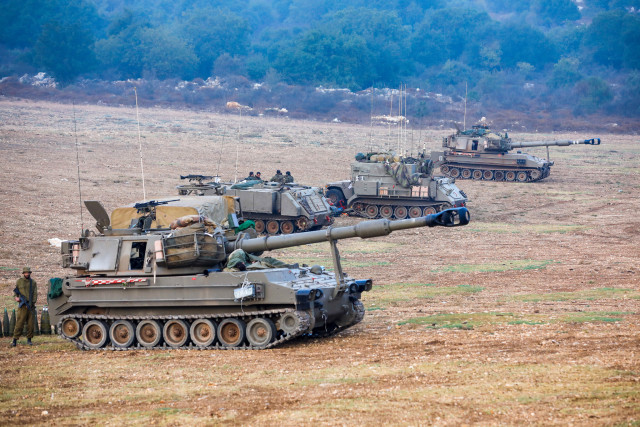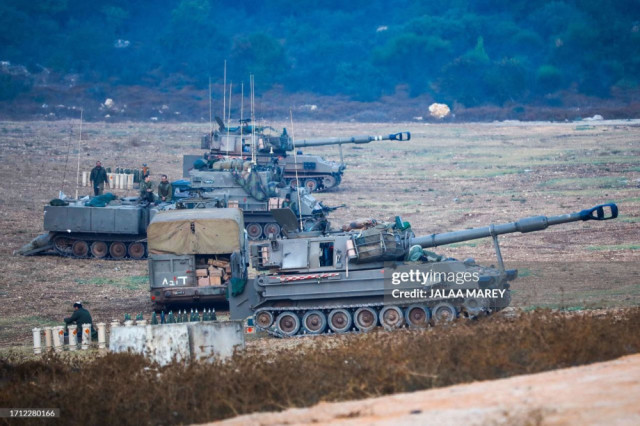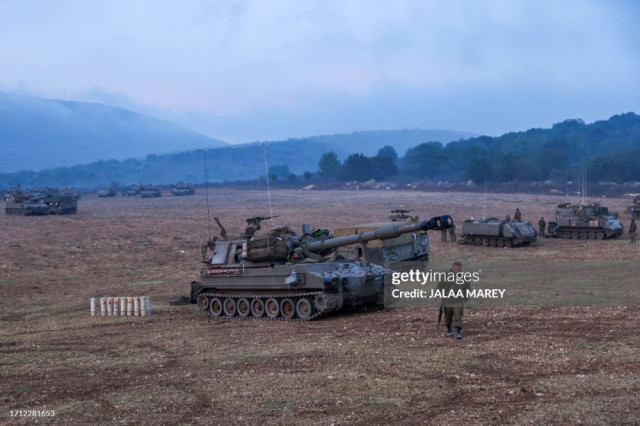A photo shoot taken on the morning of October 8, 2023 by an AFP correspondent in the area of the Lebanese-Israeli border of Israeli artillery units deployed there to repel possible attacks by the Lebanese Hezbollah on 155 mm/39 M109A5 self-propelled howitzers (Doher) clearly shows how the Israeli army imagines a "modern war". Self-propelled guns, closely deployed in a completely open place "wheel to wheel", mixed with special machines, without any disguise and surrounded by stacks of ammunition. It is obvious that the possibility of counter-battery warfare on the part of the enemy is not assumed in principle, and Israeli gunners (representatives of a nation that was considered a leader in the development of unmanned vehicles yesterday) do not suspect the existence of barrage ammunition, UAVs, quadrocopters and FPV drones.

155 mm/39 self-propelled howitzers M109A5 (Doher) of the Israeli army deployed near the border with Lebanon, 08.10.2023 (c) Jalaa Marey / AFP
This "non-obscurity" is also visible in a number of other scenes that have been supplied in abundance since the next Arab-Israeli war that began on October 7. Tanks, easily hit by single copters. Dense piles of Israeli infantry huddled together, moving during the sweeps in the settlements captured by Hamas - obviously accustomed to acting against single lightly armed Palestinians, but if the enemy has imaginary group weapons, this will surely lead to the heaviest losses. It is significant that this problem was noted by observers during the fighting of the Israeli army in Lebanon in 2006, but the who, it seems, is still there.
The point, of course, is not in individual tactical problems of the Israel Defense Forces (IDF). The unprecedented attack by Hamas from the Gaza Strip on Israel on October 7, 2023 demonstrated the systemic crisis of the Israeli military organization, which rested on the experience and achievements of a long period of successful wars against the Arabs. Firstly, the reservist system of building AOI itself is obviously problematic in modern conditions, with the dissolution of most of the military personnel for the weekend. As a result, apparently, the AOI simply does not have not only a sufficient number of units of constant readiness, but even a sufficient number of people at the points of permanent deployment of units. Regular units turn out to be, in fact, also a mobilization fiction. Even in the obviously dangerous direction of the border with the Gaza Strip, there were no people not only for the protection and defense of the border line itself and the checkpoint on it, but even for the self-protection of the PPD of military units.
With the demonstrated unavailability of regular units, it can be assumed that the reservist units of the AOI have generally lower combat readiness and training (as shown by the Lebanese War in 2006). It seems that Israel needs to move towards greater professionalization and "regularization" of the army - which, of course, will require a different level of military spending.
Alas, history shows that a good army is forged more from defeats and failures than from victories. Let's omit the visual nearest examples. Israel has historically had a fair amount of reasons to cultivate stupidity in the style of "we can repeat", and prolonged intoxication with its own successes, combined with hypertrophied nationalism, also led the Israeli military system to all the obvious results of this in practice - arrogance, cooking the military organization "in its own juice", overestimating the value of its own experience and its own achievements, disregard for the experience of other countries and other conflicts, miscalculations in assessing important areas of military development, underestimating the enemy. Even the Lebanese war of 2006 revealed many problematic moments that were revealed later in Ukraine in 2022-2023 - the high vulnerability of tanks and armored vehicles, the difficulties of overcoming enemy fortified positions and the general crisis of "maneuverability", the increasing "transparency" of the battlefield. By and large, only the Hezbollah group's lack of full-fledged artillery and normal air defense means at that time, which allowed Israeli artillery and aviation to operate almost in landfill conditions, did not allow the fighting in Lebanon to slide into a pure positional crisis in the spirit of the current Ukrainian war. However, it still didn't work out for AOI with "little blood" to have another quick triumph. And the enemy then showed himself to be generally well technically prepared, trained and morally resistant.
It cannot be said that Israel, which is still a democratic society, did not hear the "Lebanese call" of 2006. A whole "Grape Commission" was created, which made a lot of recommendations in the field of military construction. But now, in retrospect, it is obvious that no serious conclusions were made by Israeli society and the Israeli military-political elite. Actually, democracy in itself is not a guarantee of the success of military construction, especially if the military caste of the country is extremely self-confident - the example of pre-war France is indicative.
The main problem for Israel, clearly demonstrated first in Lebanon in 2006, and now by the events of October 7, is the change in the nature and level of its opponents. The legendary victories of Israel from 1948 to 1982 were the victories of a largely modern industrial urbanized society over the armed forces of backward largely agrarian "peasant" Arab societies, over the armies of the "Fellahs". It is from there that the notorious stories about the "inferior" Arab "mentality" for modern war and successful military construction come. However, Arab societies are rapidly changing, urbanizing, becoming urban, educated and entering the "information society". Moreover, paradoxically, this process is fastest going on in the territories adjacent to Israel (and occupied by it) (the neighborhood with developed Israel helps a lot here). Gaza is now not a village, but rather a large metropolis with an urban population. This makes the level of Arab organization and self-organization, including military, radically higher, and gives other opportunities in the use of military equipment and modern weapons. In 10-20 years, conditionally, every resident of Gaza will have his own combat quadcopter. What will Israel do? Exactly the same processes are taking place on an even larger scale in such an existential Israeli enemy as Iran, then other Arab countries, even the most backward, will approach this. The Arab armed forces and formations are actively modernizing in all respects. The combat experience of the Yemeni Houthis (by the way, with the support of Iran) shows the successful integration of the most modern methods of warfare and forces and means even by a very archaic society. And this is not to mention the prospects of Iran, and possibly, sooner or later, other Arab countries, obtaining nuclear weapons. Is Israel ready for war with a completely different, qualitatively Arab opponent? The events of October 7 and howitzers in an open field on the Lebanese border on October 8 show that I am not ready.
Will Israel be able to find a solution? Given the current trends in the development of Israeli politics, it is not a fact at all. The most important thing is that Israel has no long-term vision of solving the problem of the Gaza Strip and the occupied Palestinian territories in principle. The consensus approach of the current Israeli establishment is to sabotage any peace process and preserve the "status quo" in the form of "Bantustanization" of Palestine for an indefinite period. In fact, if we discard tactical zigzags and phraseology, the United States is forced to condone this Israeli policy, thereby encouraging it. In essence, this position of Israel is the position of an ostrich with its head in the sand. How long will it be possible to maintain this position in the light of the progress of Palestinian society, leading, among other things, to an increase in the effectiveness of Palestinian actions militarily? On October 7, an Israeli ostrich got a good kick in the ass. If the current trends continue, then sooner or later Israel may find itself facing, if not a catastrophe, then the hardest tests.


155 mm/39 self-propelled howitzers M109A5 (Doher) of the Israeli army deployed near the border with Lebanon, 08.10.2023 (c) Jalaa Marey / AFP
